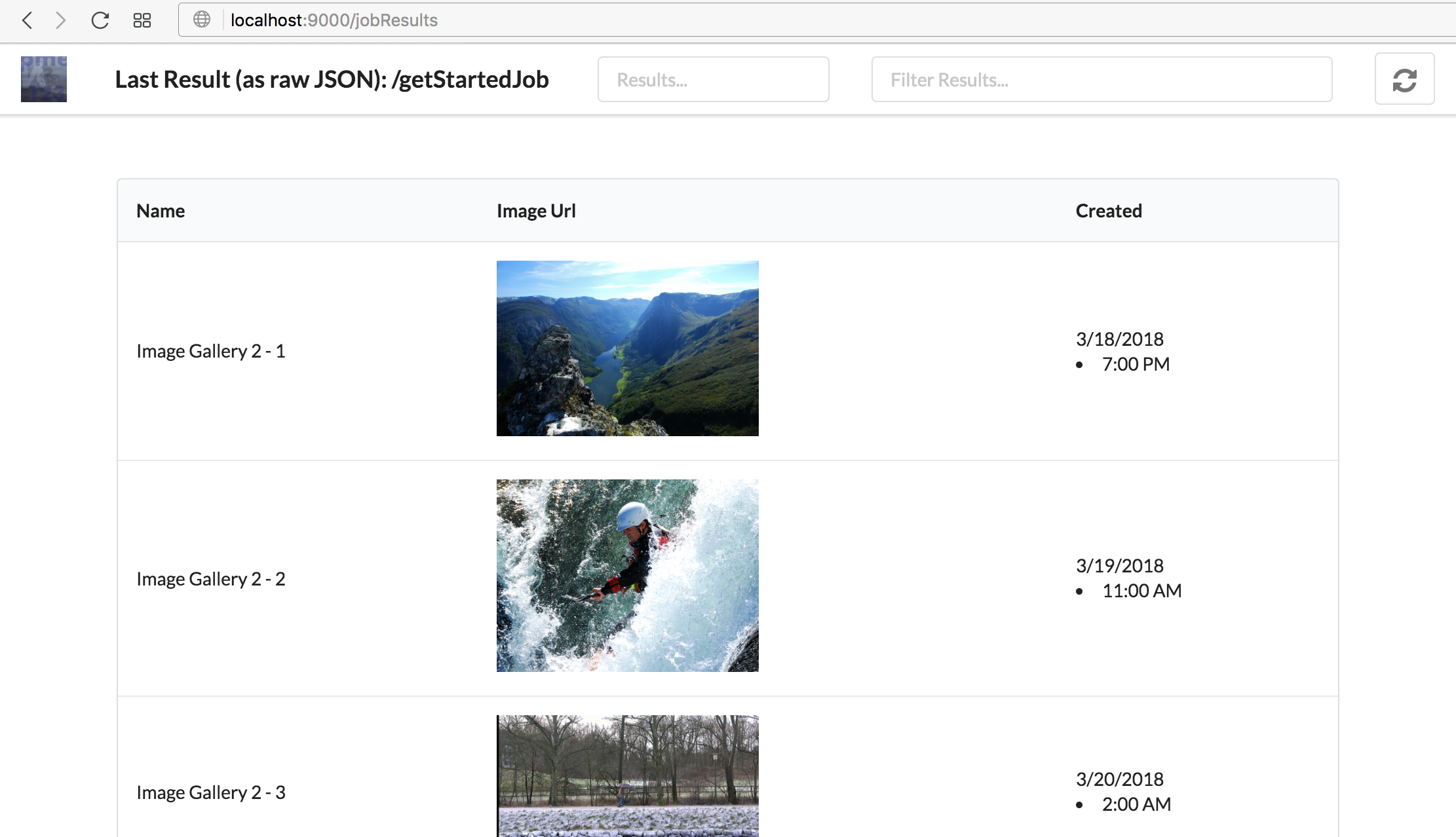Job Results
Create and use Job Results.
The example is based on DemoResultClient from scala-adapters.
Constraints
- You have created the project with scala-adapters-g8.
- You have your Job ready (server-jobs).
- The Job must create some result (like data from a webservice request).
Shared Data
One of the big advantages of having Scala on the server and the client is that you have to define the data you exchange only once!
So lets create /shared/src/main/scala/shared/GetStartedResult
case class GetStartedResult(name: String, imgUrl: String, created: DateTimeString)
object GetStartedResult {
implicit val jsonFormat: OFormat[GetStartedResult] = Json.format[GetStartedResult]
}In essence this needs 2 lines of code:
- Define the Data as a Case Class (this could also be a complex structure of case classes).
- Provide a Json -marshaller/ -un-marshaller.
Client Configuration
The client you use is defined by configuration (see reference.conf of scala-adapters)
In your get-started Project you have:
project.config {
name = "get-started"
client.name = "DefaultClient"
page.title = "Get Started Adapter"
}We only have to replace "DefaultClient" to "GetStartedClient"
Create Client
scala-adapters provides a default implementation (client.name = "DefaultClient")
object DefaultClient {
LoggerConfig.factory = ConsoleLoggerFactory()
// @JSExportTopLevel exposes this function with the defined name in Javascript.
// this is called by the index.scala.html of the server.
// the only connection that is not type-safe!
@JSExportTopLevel("client.DefaultClient.main")
def mainPage(context: String
, websocketPath: String
, clientType: String): Unit = {
ClientType.fromString(clientType) match {
case JOB_PROCESS =>
JobProcessView(context, websocketPath).create()
case JOB_RESULTS =>
DefaultView("there is no JobResults page defined").create()
case CUSTOM_PAGE =>
DefaultView("there is no custom page defined").create()
case other => warn(s"Unexpected ClientType: $other")
}
}
}Lets create the Client from that: /client/src/main/scala/client/GetStartedClient.scala
We create an implementation for the case JOB_RESULTS =>:
object GetStartedClient
extends ClientImplicits // explanations below
with Logger {
...
// "client.CLIENT_NAME.main" - where CLIENT_NAME must match client.name from reference.conf
@JSExportTopLevel("client.GetStartedClient.main")
def main(context: String, websocketPath: String, clientType: String): Unit = {
...
case JOB_RESULTS =>
JobResultsView(context
, websocketPath
, CustomResultsInfos(Seq("Name", "Image Url", "Created")
,
s"""<ul>
<li>name, imgUrl: String, * matches any part. Examples are name=Example*, subject=*Excel*</li>
<li>$dateTimeAfterL: take created from the defined DateTime, for example: 2017-12-22T12:00</li>
<li>$dateTimeBeforeL: take created until the defined DateTime, for example: 2018-01-22T23:00</li>
</ul>""")
)(GetStartedResultForJobResultsRow).create() // even it's implicit - GetStartedResultForJobResultsRow is needed here
...
}
}
}The Implementation has 2 new elements:
CustomResultsInfosthat defines the header of the result table and a Tooltip for the Result Filter.GetStartedResultForJobResultsRowis the Type Class instance for GetStartedResult that is used to create a JobResultsRow.
Here is its implementation:
private implicit object GetStartedResultForJobResultsRow extends ConcreteResult[JobResultsRow] {
override def fromJson(lastResult: JsValue): JsResult[JobResultsRow] =
Json.fromJson[GetStartedResult](lastResult)
.map(dr => JobResultsRow(
Seq(td(dr.name), tdImg(dr.imgUrl), tdDateTime(dr.created))))
}
@dom
private def tdDateTime(dateTimeStr: String) =
<td>
{s"${jsLocalDate(dateTimeStr)}"}
<li>{jsLocalTime(dateTimeStr)}</li>
</td>It creates a row of the Result Table, using predefined elements provided by a Utility.
tdDateTime is an example on how to customize a table cell.
Adjust the JobProcess
We need 2 things: First: A Result object that handles filtering and sorting:
case class GetStartedResults(results: Seq[GetStartedResult])
extends AConcreteResult
with Logger {
// type class instance for GetStartedResult
implicit object filterableGetStartedResult extends Filterable[GetStartedResult] {
// column to sort results
def sortBy(filterable: GetStartedResult): String = filterable.name
// filters the results
def doFilter(filterable: GetStartedResult)(implicit filters: Map[String, String]): Boolean = {
matchText("name", filterable.name) &&
matchText("imgUrl", filterable.imgUrl) &&
matchDate(dateTimeAfterL, filterable.created, (a, b) => a <= b) &&
matchDate(dateTimeBeforeL, filterable.created, (a, b) => a >= b)
}
}
// method to filter the results for a ClientConfig
def clientFiltered(clientConfig: ClientConfig): Seq[JsValue] =
ClientConfig.filterResults(results, clientConfig)
.map(dr => Json.toJson(dr))
// merge the results with an existing one
def merge(other: AConcreteResult): AConcreteResult = other match {
case GetStartedResults(toMerge) =>
GetStartedResults(results ++ toMerge)
case unexpected =>
warn(s"Not expected message: $unexpected")
this
}
}Second: A small change in the JobProcess:
import akka.pattern.ask
...
jobActor ? LastResult(GetStartedResults(Nil)) // reset last result
// replace results.foreach(doSomeWork) with:
results.foreach { dr =>
doSomeWork(dr)
jobActor ? LastResult(GetStartedResults(Seq(dr)), append = true)
}
...Check Result
Running the Project and running the Job, should give you this:

Check your implementation:
- tooltip of the Filter Results..
- header of table
- row of table (the list element of the time)